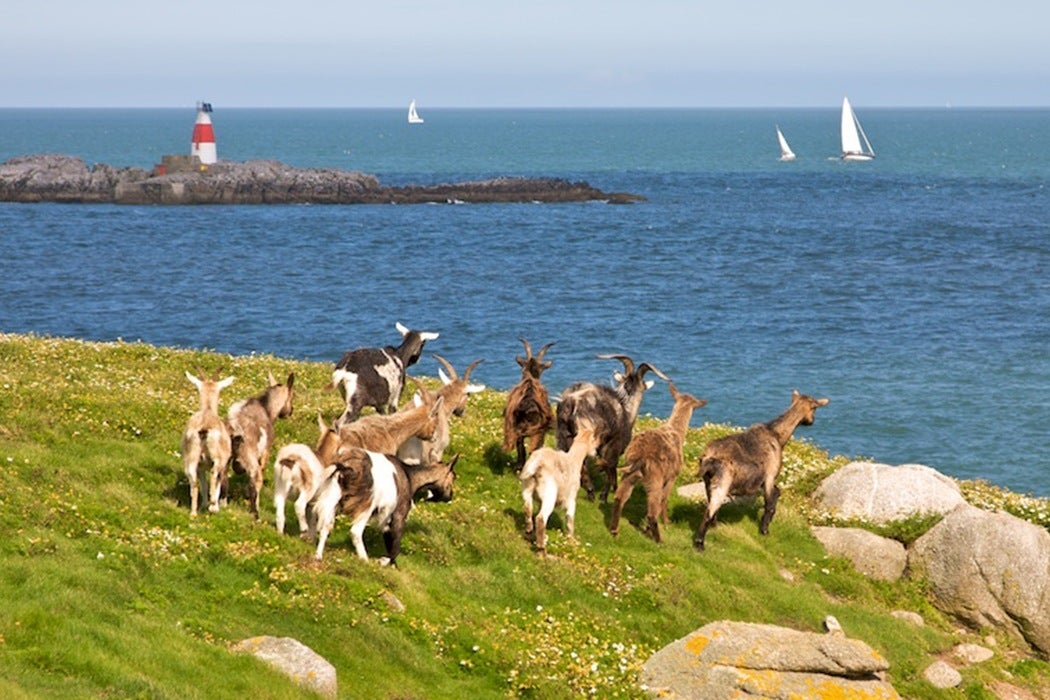Back in college, I spent a summer working at a reconstructed historical village. I didn’t wear a costume—my job was in the farm department, potting medicinal herbs and mucking out cow stalls. If there was a mullein emergency in the village, or a sheep suffering from an overgrown hoof, I’d rush in (in my 21st -century clothes) to save the day. On the way I’d pass historical reenactors huddled outside the back gate on their smoke breaks, mobcaps askew, muttering into cell phones.
It was there that I first encountered island-dwelling goats. The village goats, my boss explained, were a historical breed resembling goats brought to the New World in 1620. This breed, called Arapawas, had existed untouched for centuries on an island in New Zealand, where they were (allegedly) introduced by Captain Cook on his around-the-world voyage. Bred out of existence in England, they continued to thrive on a tiny island halfway around the world—goats as time capsules. It was just weird enough to be fascinating.
Working at the village gave me great respect for goats. They’re crafty. They’re hardy. When you try to capture them for vaccinations, they employ evasive maneuvers that leave you (me) face-down in the mud. They also happen to be killing machines.
Early North American settlers had a method for clearing forested areas without heavy machinery. Step one: let the goats in. They eat the understory plants and chew the bark off the trees, killing them. Step two: let the pigs in. They root up the tree stumps. Voila! A plantable field.
Goats as time capsules. Goats as brushcutters. Only later did I understand how disastrous this combination could be.
* * *
Island ecosystems are precious, precarious beasts, laboratories for the evolution of unique and endemic species that are terrible at self-preservation. Since 1500, half of recorded extinctions have occurred on islands. Ever since humans began moving around the world, we’ve wreaked havoc by unleashing novel species in sensitive island ecosystems. Rats, rabbits, cats, goats: we love species that breed fast and have voracious, generalist appetites. For an island native, it’s a perfect storm of destruction.
Even in this elite company, goats stand out. On their 19th-century voyages, both Charles Darwin and Alfred Russel Wallace observed the effects of introducing goats on island vegetation. Darwin, describing St. Helena, noted that “as goats and hogs were at that time suffered to range about, all the young trees had been devoured [and] succeeded by indigenous wire grass, which now spreads over its whole extent. This place is now so utterly desert, that nothing but so well-attested an account could make me believe that trees had ever existed there.”
Unlike many invasive species, goats don’t arrive accidentally; they’re brought. Goat introductions on remote islands were once common practice—to provide food for shipwrecked sailors. Darwin’s Galapagos expedition relied on introducing goats to supplement the explorers’ diets. Alexander Selkirk, the real-life Robinson Crusoe, survived five years as a castaway on the Juan Fernandez Islands of Chile by eating meat and milk from goats introduced by earlier sailors. In 1928, explorer R.H. Beck defended releasing three goats on remote Henderson Island: “the possible benefits to future ship-wrecked crews would completely overbalance possible damage to the few species of animal life occurring there.”
Although Beck’s efforts did not create a viable population, a similar introduction on Great Island in New Zealand was more successful. Four goats released by the Marine Department to provide food for castaways grew to 393 over 50 years, causing massive deforestation. Naturalist E.G. Turbott reported the loss of nearly a third of the island’s indigenous species of forest birds, as well as seabirds and small mammals unable to burrow in trampled soil. He dubbed goats “the most evidently destructive of man’s animal satellites.”
* * *
In recent decades, support has grown for eradicating goats and other invasive species from the islands where they have been introduced. However, even a few goats getting left behind can undo an entire eradication effort, and those last few can be difficult to find.
It took more than four years and $6 million to eradicate a population of 79,000 goats from the Galapagos island of Santiago. A third of that money was spent on the last 1,000 goats alone, an effort aided by radio telemetry. “Judas goats,” radio-collared goats released to join existing flocks, can help lead hunters to remnant groups, while collared females in estrus (“Mata Hari goats”) act as bait for solitary males. Successful eradication efforts in northwest Mexico, California, Hawaii, and New Zealand have all relied on these techniques to achieve 100% goat-free islands.
The results are striking. Within a week of eradication on Great Island, “all members of the expedition were impressed by the vigorous growth of young grass and herbs.” Photos from Santiago show fields of packed dirt replaced by undulating grasslands. Eradication, though brutal and expensive, seems to be the only viable solution.
* * *
Today, it’s difficult to argue for maintaining flocks of goats as food for shipwrecked sailors. But what about the time capsule effect? Don’t we risk losing a piece of history by eradicating genetically preserved populations of island goats?
In California’s Channel Islands, the San Clemente Island goat has now been removed from the island that gave it both its name and its distinctive genetics. However, more than 3,000 goats relocated from the island to mainland farms have kept the breed alive. Similar programs have targeted other “heritage breeds,” preserving them in farms and museums worldwide. From the six goats imported by the museum where I once worked, fifteen U.S. breeders now breed Arapawas.
It’s hard not to appreciate goats—for their tenacity, intelligence, and will to survive. After all, we humans share the same traits, and the same destructive power. I, for one, appreciate them most where they do the least damage: as part of our farms and our history.







